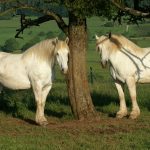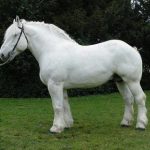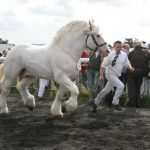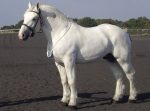Boulonnais Horse
The Boulonnais Horse is a rare French breed, famous for their characteristic marble-white coat, from which it gets its other name White Marble Horse. They are considered as one of the best varieties of heavy draft horses and are often used by the modern-day breeders for improving different other draft breeds. The Boulonnais horses are known for their energetic gaits and are mostly used for pulling carriages, field works, as well as general riding.
Boulonnais Horse Pictures
- Boulonnais Horse Foal
- Boulonnais Horse Images
- Boulonnais Horse Photos
- Boulonnais Horse Pictures
- Boulonnais Horse Stallion
- Boulonnais Horse
- Boulonnais Horses
- Boulonnais
Quick Information
| Behavioral Characteristics | Sociable, lively, easy going, adaptable |
| Physical Traits | The built is massive with a short but elegant head with a broad forehead, a muscular neck, wide chest, and a straight back; the legs are solid and sturdy having distinct joints, while the mane and the tail are highly dense |
| Coat Colors | Most common color is gray; however, the rare black and chestnut are also allowed by the breed registry |
| Height/Size | 15.1 – 16.3 hands (adult) |
| Weight | 1320 pounds (heavy) |
| Common Uses | Jumping, dressage, eventing, endurance, meat |
| Health Problems | Generally healthy |
| Type | Driving horse, Riding horse, Work horse, Show horse |
| Blood Type | Warm |
| Popular Traits | Smooth gaits, versatile, easy trainability |
| Feeding/Diet | General horse diet including hay, grass, grains, etc. |
| Country of Origin | France |
| Associations and Registries | Breed Standards |
Video: The Boulonnais Horses Show
History and Development
The origin of the Boulonnais can be traced back to the time of the Crusaders and is thought to have been brought to the region by the Roman emperor Julius Caesar before the invasion of Britain.
Since its creation in the Boulogne District of France (from which it gets its name), the Boulonnais has always been a favorite to the ordinary people as one of the ablest and good looking draft breeds. Initially, the horse had a few sub-types, starting from the slim types to the heavier ones. All of these horses began to be crossbred and eventually reduced to just one, as is seen today.
Again, in the 17th century, the blood of other breeds, viz. the Asian, the Spanish Barb, the Andalusian and the Arabian, were introduced for further improvement. Interestingly, black and bay Boulonnais were quite common in the 18th century. However, with its decline in numbers, it’s only the dominant grey gene that superseded the other coat colors.
By the early half of the 1900s, these horses began to get quite popular in France and imported to the US. However, during the World War II, the number of these horses that existed in Europe decreased severely, leaving the population almost extinct. However, during the 1970s, these horses began to grow in numbers and became a popular choice for horse meat.
Today, the number of these horses is still quite low with lesser than 1,000 horses remaining in the entire European continent, with its density being the most in France. At present, active selective breeding programs have been undertaken by the French government on a priority basis, in order to preserve the breed.











